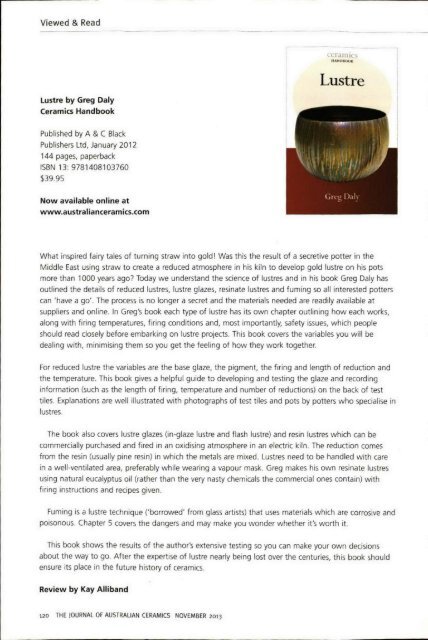The Journal of Australian Ceramics Vol 52 No 3 November 2013
You also want an ePaper? Increase the reach of your titles
YUMPU automatically turns print PDFs into web optimized ePapers that Google loves.
Viewed & Read<br />
ccraolics<br />
IU!(O~<br />
Lustre<br />
Lustre by Greg Daly<br />
<strong>Ceramics</strong> Handbook<br />
Published by A & C Black<br />
Publishers Ltd, January 2012<br />
144 pages, paperback<br />
ISBN 13: 9781408103760<br />
$39.95<br />
<strong>No</strong>w available online at<br />
www.australianceramics.com<br />
What inspired fairy tales <strong>of</strong> turning straw into gold! Was this the result <strong>of</strong> a secretive potter in the<br />
Middle East using straw to create a reduced atmosphere in his kiln to develop gold lustre on his pots<br />
more than 1000 years ago? Today we understand the science <strong>of</strong> lustres and in his book Greg Daly has<br />
outlined the details <strong>of</strong> reduced lustres, lustre glazes, resinate lustres and fuming so all interested potters<br />
can 'have a go'. <strong>The</strong> process is no longer a secret and the materials needed are readily available at<br />
suppliers and online. In Greg's book each type <strong>of</strong> lustre has its own chapter outlining how each works,<br />
along with firing temperatures, firing conditions and, most importantly, safety issues, which people<br />
should read closely before embarking on lustre projects. This book covers the variables you will be<br />
dealing with, minimising them so you get the feeling <strong>of</strong> how they work together.<br />
For reduced lustre the variables are the base glaze, the pigment, the firing and length <strong>of</strong> reduction and<br />
the temperature. This book gives a helpful guide to developing and testing the glaze and recording<br />
information (such as the length <strong>of</strong> firing, temperature and number <strong>of</strong> reductions) on the back <strong>of</strong> test<br />
tiles. Explanations are well illustrated with photographs <strong>of</strong> test tiles and pots by potters who specialise in<br />
lustres.<br />
<strong>The</strong> book also covers lustre glazes (in·glaze lustre and flash lustre) and resin lustres which can be<br />
commercially purchased and fired in an OXidising atmosphere in an electric kiln. <strong>The</strong> reduction comes<br />
from the resin (usually pine resin) in which the metals are mixed. Lustres need to be handled with care<br />
in a well·ventilated area, preferably while wearing a vapour mask. Greg makes his own resinate lustres<br />
using natural eucalyptus oil (rather than the very nasty chemicals the commercial ones contain) with<br />
firing instructions and recipes given.<br />
Fuming is a lustre technique ('borrowed' from glass artists) that uses materials which are corrosive and<br />
poisonous. Chapter 5 covers the dangers and may make you wonder whether it's worth it.<br />
This book shows the results <strong>of</strong> the author'S extensive testing so you can make your own decisions<br />
about the way to go. After the expertise <strong>of</strong> lustre nearly being lost over the centuries, this book should<br />
ensure its place in the future history <strong>of</strong> ceramics.<br />
Review by Kay Alliband<br />
120 THE JOURNAL OF AUSTRALIAN CERAMICS NOVEMBER <strong>2013</strong>

















